Earliest Cambrian Carbonate Platform Evolution, Environmental Change, and Organic Matter Accumulation in the Northwestern Yangtze Block, South China
Abstract
1. Introduction
2. Geological Setting
3. Data and Methods
3.1. Facies and Sequence Stratigraphic Analyses
3.2. Carbon and Oxygen Isotope Analyses
3.3. Lithium, Strontium Isotope, and Elemental Concentration Analyses of Carbonate Leachates
4. Results
4.1. Facies Analysis
4.1.1. Facies Association 1: Foredeep Basin
4.1.2. Facies Association 2: Backbulge Basin
4.1.3. Facies Association 3: Outer Ramp
4.1.4. Facies Association 4: Mid-Ramp
4.1.5. Facies Association 5: Inner Ramp
4.1.6. Facies Association 6: Prograding Slope and Platform Margin
4.1.7. Facies Association 7: Platform Interior
4.2. Sequence Stratigraphic Analysis
4.2.1. Stratal Stacking Pattern 1: Transgressive Systems Tract
4.2.2. Stratal Stacking Pattern 2: Highstand Systems Tract
4.2.3. Stratal Stacking Pattern 3: Falling-Stage Systems Tract
4.2.4. Stratal Stacking Pattern 4: Lowstand Systems Tract
4.3. Geochemical Analysis
4.3.1. Carbon and Oxygen Isotopic Profiles
4.3.2. Lithium and Strontium Isotopic Profiles
4.3.3. Element Contents
4.3.4. Reliability Evaluation of Geochemical Data
4.4. Sequence Stratigraphic Framework
5. Discussion
5.1. Carbonate Platform Evolution
5.2. Paleoenvironmental Change
5.3. Organic Matter Accumulation
6. Conclusions
Supplementary Materials
Author Contributions
Funding
Data Availability Statement
Acknowledgments
Conflicts of Interest
References
- Maloof, A.C.; Porter, S.M.; Moore, J.L.; Dudás, F.Ö.; Bowring, S.A.; Higgins, J.A.; Fike, D.A.; Eddy, M.P. The earliest Cambrian record of animals and ocean geochemical change. Geol. Soc. Am. Bull. 2010, 122, 1731–1774. [Google Scholar] [CrossRef]
- Maloof, A.C.; Ramezani, J.; Bowring, S.A.; Fike, D.A.; Porter, S.M.; Mazouad, M. Constraints on early Cambrian carbon cycling from the duration of the Nemakit-Daldynian–Tommotian boundary δ13C shift, Morocco. Geology 2010, 38, 623–626. [Google Scholar] [CrossRef]
- Lyons, T.W.; Reinhard, C.T.; Planavsky, N.J. The rise of oxygen in Earth’s early ocean and atmosphere. Nature 2014, 506, 307–315. [Google Scholar] [CrossRef] [PubMed]
- Erwin, D.H.; Laflamme, M.; Tweedt, S.M.; Sperling, E.A.; Pisani, D.; Peterson, K.J. The Cambrian conundrum: Early divergence and later ecological success in the early history of animals. Science 2011, 334, 1091–1097. [Google Scholar] [CrossRef]
- Zhu, M.; Strauss, H.; Shields, G.A. From snowball earth to the Cambrian bioradiation: Calibration of Ediacaran–Cambrian earth history in South China. Palaeogeogr. Palaeoclimatol. Palaeoecol. 2007, 254, 1–6. [Google Scholar] [CrossRef]
- Zhao, G.; Wang, Y.; Huang, B.; Dong, Y.; Li, S.; Zhang, G.; Yu, S. Geological reconstructions of the East Asian blocks: From the breakup of Rodinia to the assembly of Pangea. Earth-Sci. Rev. 2018, 186, 262–286. [Google Scholar] [CrossRef]
- Li, C.; Zhu, M.; Feng, Q.; Clausen, S. The co-evolution of life and environments in South China from Snowball Earth to Cambrian Explosion. Palaeogeogr. Palaeoclimatol. Palaeoecol. 2021, 563, 110181. [Google Scholar] [CrossRef]
- Li, C.; Cheng, M.; Zhu, M.; Lyons, T.W. Heterogeneous and dynamic marine shelf oxygenation and coupled early animal evolution. Emerg. Top. Life Sci. 2018, 2, 279–288. [Google Scholar] [CrossRef]
- Wood, R.; Liu, A.G.; Bowyer, F.; Wilby, P.R.; Dunn, F.S.; Kenchington, C.G.; Cuthill, J.F.H.; Mitchell, E.G.; Penny, A. Integrated records of environmental change and evolution challenge the Cambrian Explosion. Nat. Ecol. Evol. 2019, 3, 528–538. [Google Scholar] [CrossRef]
- Li, C.; Shi, W.; Cheng, M.; Jin, C.; Algeo, T.J. The redox structure of Ediacaran and early Cambrian oceans and its controls. Sci. Bull. 2020, 65, 2141–2149. [Google Scholar] [CrossRef] [PubMed]
- Sun, X.; Heubeck, C.; Steiner, M.; Yang, B. Environmental setting of the Cambrian Terreneuvian rocks from the southwestern Yangtze Platform, South China. Palaeogeogr. Palaeoclimatol. Palaeoecol. 2020, 538, 109424. [Google Scholar] [CrossRef]
- Compston, W.; Zhang, Z.; Cooper, J.A.; Ma, G.; Jenkins, R.J.F. Further SHRIMP geochronology on the early Cambrian of South China. Am. J. Sci. 2008, 308, 399–420. [Google Scholar] [CrossRef]
- Zi, J.; Jia, D.; Wei, G.; Yang, Z.; Zhang, Y.; Hu, J.; Shen, S. LA-ICP-MS U-Pb zircon ages of volcaniclastic beds of the third member of the Sinian (Ediacaran) Dengying Formation in Leshan, Sichuan, discussion on the rift evolution in the basin. Geol. Rev. 2017, 63, 1040–1049, (In Chinese with English Abstract). [Google Scholar]
- He, L.; Liu, J.; Chen, F.; He, P.; He, J. The chronology and geochemical characteristics of rhyolite at the top of Lower Cambrian Maidiping Formation in Yongshan area, northeast Yunnan. Mineral. Petrol. 2020, 40, 7–19, (In Chinese with English Abstract). [Google Scholar]
- Yang, B.; Steiner, M.; Zhu, M.; Li, G.; Liu, J.; Liu, P. Transitional Ediacaran–Cambrian small skeletal fossil assemblages from South China and Kazakhstan: Implications for chronostratigraphy and metazoan evolution. Precambrian Res. 2016, 285, 202–215. [Google Scholar] [CrossRef]
- Pan, X.; Xiong, L.; Dai, Q.; Luo, J.; Liu, Z.; Wang, T.; Hua, H. Phosphatized Obruchevella and other microfossils from the Ediacaran-Cambrian transition (Terreneuvian, Maidiping Formation), southern Sichuan Province, China. Precambrian Res. 2022, 380, 106825. [Google Scholar] [CrossRef]
- Feng, Q.; Pan, B.; Yang, A.; Lu, M.; Li, G. biostratigraphy of the small shelly fossils from the upper maidiping formation (Terreneuvian) at the Fandian section, Sichuan Province, South China. Front. Earth Sci. 2022, 10, 922439. [Google Scholar] [CrossRef]
- Goldberg, T.; Strauss, H.; Guo, Q.; Liu, C. Reconstructing marine redox conditions for the Early Cambrian Yangtze Platform: Evidence from biogenic sulphur and organic carbon isotopes. Palaeogeogr. Palaeoclimatol. Palaeoecol. 2007, 254, 175–193. [Google Scholar] [CrossRef]
- Guo, Q.; Shields, G.A.; Liu, C.; Strauss, H.; Zhu, M.; Pi, D.; Goldberg, T.; Yang, X. Trace element chemostratigraphy of two Ediacaran–Cambrian successions in South China: Implications for organosedimentary metal enrichment and silicification in the early Cambrian. Palaeogeogr. Palaeoclimatol. Palaeoecol. 2007, 254, 194–216. [Google Scholar] [CrossRef]
- Guo, Q.; Strauss, H.; Liu, C.; Goldberg, T.; Zhu, M.; Pi, D.; Heubeck, C.; Vernhet, E.; Yang, X.; Fu, P. Carbon isotopic evolution of the terminal Neoproterozoic and early Cambrian: Evidence from the Yangtze Platform, South China. Palaeogeogr. Palaeoclimatol Palaeoecol. 2007, 254, 140–157. [Google Scholar] [CrossRef]
- Cremonese, L.; Shields-Zhou, G.; Struck, U.; Ling, H.-F.; Och, L.; Chen, X.; Li, D. Marine biogeochemical cycling during the early Cambrian constrained by a nitrogen and organic carbon isotope study of the Xiaotan section, South China. Precambrian Res. 2013, 225, 148–165. [Google Scholar] [CrossRef]
- Li, D.; Ling, H.-F.; Shields-Zhou, G.A.; Chen, X.; Cremonese, L.; Och, L.; Thirlwall, M.; Manning, C.J. Carbon and strontium isotope evolution of seawater across the Ediacaran–Cambrian transition: Evidence from the Xiaotan section, NE Yunnan, South China. Precambrian Res. 2013, 225, 128–147. [Google Scholar] [CrossRef]
- Brasier, M.D.; Magaritz, M.; Corfield, R.; Huilin, L.; Xiche, W.; Lin, O.; Zhiwen, J.; Hamdi, B.; Tinggui, H.; Fraser, A.G. The carbon-and oxygen-isotope record of the Precambrian–Cambrian boundary interval in China and Iran and their correlation. Geol. Mag. 1990, 127, 319–332. [Google Scholar] [CrossRef]
- Peng, S.C.; Babcock, L.E.; Ahlberg, P. The Cambrian Period. In Geologic Time Scale 2020; Gradstein, F.M., Ogg, J.G., Schmitz, M.D., Ogg, G.M., Eds.; Elsevier: Amsterdam, The Netherlands, 2020; pp. 565–629. [Google Scholar]
- Sun, L.; Khan, M.M.S.S.; Yang, C.; Sun, Z.; Pan, B.; Ahmed, S.; Miao, L.; Sun, W.; Hu, C.; Sun, X. Cryogenian and Ediacaran integrative stratigraphy, biotas, and paleogeographical evolution of the Qinghai-Tibetan Plateau and its surrounding areas. Sci. China Earth Sci. 2024, 67, 919–949. [Google Scholar] [CrossRef]
- Gao, P.; Li, S.; Lash, G.G.; Yan, D.; Zhou, Q.; Xiao, X. Stratigraphic framework, redox history, and organic matter accumulation of an Early Cambrian intraplatfrom basin on the Yangtze Platform, South China. Mar. Pet. Geol. 2021, 130, 105095. [Google Scholar] [CrossRef]
- Scotese, C.R. PALEOMAP PaleoAtlas for GPlates and the PaleoData Plotter Program, PALEOMAP Project. 2016. Available online: https://www.earthbyte.org/paleomap-paleoatlas-for-gplates/ (accessed on 5 March 2025).
- Gu, Z.; Jian, X.; Watts, A.B.; Zhai, X.; Liu, G.; Jiang, H. Formation and evolution of an Early Cambrian foreland basin in the NW Yangtze Block, South China. J. Geol. Soc. 2022, 180, jgs2022-127. [Google Scholar] [CrossRef]
- Wu, Y.; Yin, R.; Li, C.; Chen, D.; Grasby, S.E.; Li, T.; Ji, S.; Tian, H. Global Hg cycle over Ediacaran–Cambrian transition and its implications for environmental and biological evolution. Earth Planet. Sci. Lett. 2022, 587, 117551. [Google Scholar] [CrossRef]
- Brocks, J.J.; Jarrett, A.J.; Sirantoine, E.; Hallmann, C.; Hoshino, Y.; Liyanage, T. The rise of algae in Cryogenian oceans and the emergence of animals. Nature 2017, 548, 578–581. [Google Scholar] [CrossRef]
- Zhai, L.; Wu, C.; Ye, Y.; Zhang, S.; Wang, Y. Fluctuations in chemical weathering on the Yangtze Block during the Ediacaran–Cambrian transition: Implications for paleoclimatic conditions and the marine carbon cycle. Palaeogeogr. Palaeoclimatol. Palaeoecol. 2018, 490, 280–292. [Google Scholar] [CrossRef]
- Gao, P.; He, Z.; Li, S.; Lash, G.G.; Li, B.; Huang, B.; Yan, D. Volcanic and hydrothermal activities recorded in phosphate nodules from the Lower Cambrian Niutitang Formation black shales in South China. Palaeogeogr. Palaeoclimatol. Palaeoecol. 2018, 505, 381–397. [Google Scholar] [CrossRef]
- Yeasmin, R.; Chen, D.; Fu, Y.; Wang, J.; Guo, Z.; Guo, C. Climatic-oceanic forcing on the organic accumulation across the shelf during the Early Cambrian (Age 2 through 3) in the mid-upper Yangtze Block, NE Guizhou, South China. J. Asian Earth Sci. 2017, 134, 365–386. [Google Scholar] [CrossRef]
- Liu, Z.; Zhuang, X.; Teng, G.; Xie, X.; Yin, L.; Bian, L.; Feng, Q.; Algeo, T. The lower Cambrian Niutitang Formation at Yangtiao (Guizhou, SW China): Organic matter enrichment, source rock potential, and hydrothermal influences. J. Pet. Geol. 2015, 38, 411–432. [Google Scholar] [CrossRef]
- Jin, C.; Li, C.; Algeo, T.J.; Planavsky, N.J.; Cui, H.; Yang, X.; Zhao, Y.; Zhang, X.; Xie, S. A highly redox-heterogeneous ocean in South China during the early Cambrian (~529–514 Ma): Implications for biota-environment co-evolution. Earth Planet. Sci. Lett. 2016, 441, 38–51. [Google Scholar] [CrossRef]
- Gu, Z.; Lonergan, L.; Zhai, X.; Zhang, B.; Lu, W. The formation of the Sichuan Basin, South China, during the late Ediacaran to early Cambrian. Basin Res. 2021, 33, 2328–2357. [Google Scholar] [CrossRef]
- Luo, B.; Luo, W.J.; Wang, W.Z.; Wang, Z.H.; Shan, S.J. Formation mechanism of the Sinian natural gas reservoir in the Leshan-Longnvsi Paleo-uplift, Sichuan Basin. Nat. Gas Geosci. 2015, 26, 444–455. [Google Scholar]
- Luo, B.; Yang, Y.; Luo, W.; Wen, L.; Wang, W.; Chen, K. Controlling factors and distribution of reservoir development in Dengying Formation of paleo-uplift in central Sichuan Basin. Acta Pet. Sin. 2015, 36, 416–426. [Google Scholar]
- Wang, Z.; Jiang, H.; Wang, T.; Lu, W.; Gu, Z.; Xu, A.; Yang, Y.; Xu, Z. Paleo-geomorphology formed during Tongwan tectonization in Sichuan Basin and its significance for hydrocarbon accumulation. Pet. Explor. Dev. 2014, 41, 338–345. [Google Scholar] [CrossRef]
- Zhong, Y.; Li, Y.L.; Zhang, X.B.; Liu, S.; Liu, D.; Deng, X.; Chen, S.; Sun, W.; Chen, Y. Features of extensional structures in pre-Sinian to Cambrian strata, Sichuan Basin. J. Chengdu Univ. Technol. (Sci. Technol. Ed.) 2013, 40, 498–510. [Google Scholar]
- Song, J.M.; Liu, S.G.; Sun, W.; Wu, W.H.; Wang, G.Z.; Peng, H.L.; Tian, Y.H.; Zhong, Y. Control of Xingkai taphrogenesis on Dengying Formation high quality reservoirs in Upper Sinian of Sichuan Basin. China. J. Chengdu Univ. Technol. (Sci. Technol. Ed.) 2013, 40, 658–670. [Google Scholar]
- Liu, S.G.; Sun, W.; Luo, Z.L.; Song, J.M.; Zhong, Y.; Tian, Y.H.; Peng, H.L. Xingkai taphrogenesis and petroleum exploration from upper Sinian to Cambrian strata in Sichuan Basin, China. J. Chengdu Univ. Technol. (Sci. Technol. Ed.) 2013, 40, 511–520. [Google Scholar]
- Liu, S.G.; Wang, Y.G.; Sun, W.; Zhong, Y.; Hong, H.T.; Deng, B.; Xia, M.L.; Song, J.M.; Wen, Y.C.; Wu, J. Control of intracratonic sags on the hydrocarbon accumulations in the marine strata across the Sichuan Basin. J. Chengdu Univ. Technol. (Sci. Technol. Ed.) 2016, 43, 1–23. [Google Scholar]
- Liu, S.G.; Deng, B.; Jansa, L.; Zhong, Y.; Sun, W.; Song, J.M.; Wang, G.Z.; Wu, J.; Li, Z.W.; Tian, Y.H. The Early Cambrian Mianyang-Changning intracratonic sag and its control on petroleum accumulation in the Sichuan Basin, China. Geofluids 2017, 2017, 6740892. [Google Scholar] [CrossRef]
- Wei, G.Q.; Yang, W.; Du, J.H.; Xu, C.C.; Zou, C.N.; Xie, W.R.; Zeng, F.Y.; Wu, S.J. Geological characteristics of the sinian-early cambrian intracratonic rift, Sichuan Basin. Nat. Gas Ind. 2015, 35, 24–35. [Google Scholar]
- Du, J.; Wang, Z.; Zou, C.; Xu, C.C.; Shen, P.; Zhang, B.M.; Jiang, H.; Huang, S.P. Discovery of intra-cratonic rift in the Upper Yangtze and its control effect on the formation of Anyue giant gas field. Acta Pet. Sin. 2016, 37, 1–16. [Google Scholar]
- Zhou, J.G.; Shen, A.J.; Zhang, J.Y.; Hao, Y.; Gu, M.F.; Li, W.Z. Deyang-Anyue interplatform rift in Sichuan Basin and its direction of exploration in Sinian. Mar. Orig. Pet. Geol. 2018, 23, 1–9. [Google Scholar]
- Li, Z.; Liu, J.; Li, Y.; Hang, W.; Hong, H.; Ying, D.; Chen, X.; Liu, R.; Duan, X.; Peng, J. Formation and evolution of Weiyuan-Anyue tensional corrosion trough in Sinian system, Sichuan Basin. Pet. Explor. Dev. 2015, 42, 29–36. [Google Scholar] [CrossRef]
- Li, S.J.; Gao, P.; Huang, B.Y.; Wang, H.J.; Wo, Y.J. Sedimentary constraints on the tectonic evolution of Mianyang-Changning trough in the Sichuan Basin. Oil Gas Geol. 2018, 39, 889–898. [Google Scholar]
- Li, Y.; He, D.; Li, D.; Li, S.; Wo, Y.; Li, C.; Huang, H. Ediacaran (Sinian) palaeogeographic reconstruction of the Upper Yangtze area, China, and its tectonic implications. Int. Geol. Rev. 2020, 62, 1485–1509. [Google Scholar] [CrossRef]
- Liu, J.J.; Liu, H.R.; Li, W.H.; Xie, W.R.; Jiang, H.; Su, W.; Li, W.Z.; Shi, S.Y.; Zhai, X.F.; Ma, S.Y. New progress in the study of aulacogen in the Sichuan Basin—A discussion on the genetic mechanism and formation time of the aulacogen. Geol. Rev. 2021, 67, 767–786. [Google Scholar]
- Dalrymple, R.W. Interpreting sedimentary successions: Facies, facies analysisi and facies models. In Facies Models 4; James, N.P., Dalrymple, R.W., Eds.; GEOtext 6; Geological Association of Cananda: St. John’s, NL, Canada, 2010; pp. 3–18. [Google Scholar]
- Catuneanu, O. Model-independent sequence stratigraphy. Earth-Sci. Rev. 2019, 188, 312–388. [Google Scholar] [CrossRef]
- Xia, G.; Ye, Y.; Liu, S.; Wang, H.; Song, J.; Sun, W.; Ran, B.; Jiao, K.; Xie, G.; Deng, B. Paleoenvironmental evolution and organic matter accumulation of the lower Cambrian Maidiping marine black shales in the intracratonic basin, western margin of Sichuan Basin, South China. Int. Geol. Rev. 2023, 66, 2249–2268. [Google Scholar] [CrossRef]
- Li, D.; Ling, H.-F.; Jiang, S.-Y.; Pan, J.-Y.; Chen, Y.-Q.; Cai, Y.-F.; Feng, H.-Z. New carbon isotope stratigraphy of the Ediacaran–Cambrian boundary interval from SW China: Implications for global correlation. Geol. Mag. 2009, 146, 465–484. [Google Scholar] [CrossRef]
- Deng, S.; Fan, R.; Li, X.; Zhang, S.; Zhang, B.; Lu, Y. Subdivision and correlation of the Sinian (Ediacaran) system in the Sichuan Basin and its adjacent area. J. Stratigr. 2015, 39, 239–254, (In Chinese with English Abstract). [Google Scholar]
- Wen, L.; Wang, W.; Li, L.; Hong, H.; Luo, B.; Zhang, X.; Peng, H.; Li, K.; Jia, M.; Tian, X. New understandings of the distribution characteristics of the Sinian Dengying Formation in the southwestern Sichuan Basin and its significance for oil and gas geological exploration. China Pet. Explor. 2020, 25, 56. [Google Scholar]
- Zhang, X.; Zhou, X.; Hu, D. High-resolution paired carbon isotopic records from the Meishucun section in South China: Implications for carbon cycling and environmental changes during the Ediacaran-Cambrian transition. Precambrian Res. 2020, 337, 105561. [Google Scholar] [CrossRef]
- Fu, X.; Chen, Y.; Luo, B.; Li, W.; Liu, R.; Wang, X.; He, Y.; Gu, M.; Jiang, H. Evaluation of source rocks and petroleum system of the Lower Cambrian Maidiping Formation-Qiongzhusi Formation in the Middle-Upper Yangtze region. China Pet. Explor. 2022, 27, 103. [Google Scholar]
- Yang, C.; Li, X.H.; Zhu, M.Y. Tectonic regime transition of the western South China Block in early Cambrian: Evidence from the Meishucun volcanic ash beds. Palaeoworld 2022, 31, 591–599. [Google Scholar] [CrossRef]
- Schlager, W. Carbonate Sedimentology and Sequence Stratigraphy; SEPM Concepts in Sedimentology and Paleontology #8; SEPM Society for Sedimentary Geology: Tulsa, OK, USA, 2005; p. 200. [Google Scholar]
- James, N.P.; Jones, B. Origin of Carbonate Sedimentary Rocks; John Wiley & Sons, Ltd.: Hoboken, NJ, USA, 2016; p. 464. [Google Scholar]
- Flügel, E.; Munnecke, A. Microfacies of Carbonate Rocks: Analysis, Interpretation and Application; Springer: Berlin/Heidelberg, Germany, 2010; Volume 976. [Google Scholar]
- Jelby, M.E.; Grundvåg, S.A.; Helland-Hansen, W.; Olaussen, S.; Stemmerik, L. Tempestite facies variability and storm-depositional processes across a wide ramp: Towards a polygenetic model for hummocky cross-stratification. Sedimentology 2020, 67, 742–781. [Google Scholar] [CrossRef]
- Pufahl, P.K. Bioelemental sediments. In Facies Models 4; James, N.P., Dalrymple, R.W., Eds.; GEOtext 6; Geological Association of Canda: St. John’s, NL, Canada, 2010; pp. 477–503. [Google Scholar]
- Playton, T.E.; Janson, X.; Kerans, C. Carbonate slopes. In Facies Models 4; James, N.P., Dalrymple, R.W., Eds.; GEOtext 6; Geological Association of Canada: St. John’s, NL, Canada, 2010; pp. 449–476. [Google Scholar]
- Playton, T.E.; Kerans, C. Late Devonian carbonate margins and foreslopes of the Lennard Shelf, Canning Basin, Western Australia, Part B: Development during progradation and across the Frasnian–Famennian biotic crisis. J. Sediment. Res. 2015, 85, 1362–1392. [Google Scholar] [CrossRef]
- Baum, G.R.; Vail, P.R. Sequence stratigraphic concepts applied to Paleogene outcrops, Gulf and Atlantic basins. In Sea-Level Changes—An Integrated Approach; Wilgus, C.K., Hastings, B.S., Kendall, C.G.S.G., Posamentier, H., Ross, C.A., Van Wagoner, J.C., Eds.; SEPM Special Publication 42; Society of Economic Paleontologists and Mineralogists: Tulsa, OK, USA, 1988; pp. 309–327. [Google Scholar]
- McLaughlin, P.I.; Brett, C.E. Signatures of sea-level rise on the carbonate margin of a Late Ordovician foreland basin: A case study from the Cincinnati Arch, USA. Palaios 2007, 22, 245–267. [Google Scholar] [CrossRef]
- Plint, A.G.; Nummedal, D. The falling stage systems tract: Recognition and importance in sequence stratigraphic analysis. In Sedimentary Responses to Forced Regressions; Hunt, D., Gawthorpe, R.L., Eds.; Special Publications 172; Geological Society: London, UK, 2000; pp. 1–17. [Google Scholar]
- Posamentier, H.W.; Morris, W.R. Aspects of the stratal architecture of forced regressive deposits. In Sedimentary Responses to Forced Regressions; Hunt, D., Gawthorpe, R.L., Eds.; Special Publications 172; Geological Society: London, UK, 2000; pp. 19–46. [Google Scholar]
- Plint, A.G. Sharp-base shoreface sequences and “offshore bars” in the Cardium Formation of Alberta: Their relationship to relative changes in sea-level. In Sea-Level Changes: An Integrated Approach; Wilgus, C.K., Hastings, B.S., Kendall, C.G.S.C., Posamentier, H.W., Ross, C.A., Van Wagoner, J.C., Eds.; SEPM Special Publication 42; Society of Economic Paleontologists and Mineralogists: Tulsa, OK, USA, 1988; pp. 357–370. [Google Scholar]
- Hunt, D.; Tucker, M.E. Stranded parasequences and the forced regressive wedge systems tract: Deposition during base-level fall. Sediment. Geol. 1992, 81, 1–9. [Google Scholar] [CrossRef]
- Sloss, L.L.; Krumbein, W.C.; Dapples, E.C. Integrated facies analysis. In Sedimentary Facies in Geologic History; Longwell, C.R., Ed.; Geological Society of America Memoir 39; Geological Society of America: Boulder, CO, USA, 1949; pp. 91–124. [Google Scholar]
- Van Wagoner, J.C.; Posamentier, H.W.; Mitchum, R.M.; Vail, P.R.; Sarg, J.F.; Loutit, T.S.; Hardenbol, J. An overview of the fundamentals of sequence stratigraphy and key definitions. In Sea Level Change: An Integrated Approach; Wilgus, C.K., Hastings, B.S., Kendall, C.G.S.C., Posamentier, H.W., Ross, C.A., Van Wagoner, J.C., Eds.; SEPM Special Publication 42; Society of Economic Paleontologists and Mineralogists: Tulsa, OK, USA, 1988; pp. 39–45. [Google Scholar]
- Frederiksen, J.A.; Wei, W.; Rugen, E.J.; Ling, H.-F.; Frei, R. Cadmium isotopes in Late Ediacaran–Early Cambrian Yangtze Platform carbonates–Reconstruction of bioproductivity in ambient surface seawater. Palaeogeogr. Palaeoclimatol. Palaeoecol. 2022, 601, 111096. [Google Scholar] [CrossRef]
- Wei, G.-Y.; Planavsky, N.J.; Tarhan, L.G.; Chen, X.; Wei, W.; Li, D.; Ling, H.-F. Marine redox fluctuation as a potential trigger for the Cambrian explosion. Geology 2018, 46, 587–590. [Google Scholar] [CrossRef]
- Wei, W.; Frei, R.; Gilleaudeau, G.J.; Li, D.; Wei, G.-Y.; Huang, F.; Ling, H.-F. Variations of redox conditions in the atmosphere and Yangtze Platform during the Ediacaran-Cambrian transition: Constraints from Cr isotopes and Ce anomalies. Palaeogeogr. Palaeoclimatol. Palaeoecol. 2020, 543, 109598. [Google Scholar] [CrossRef]
- Li, D.; Zhang, X.; Hu, D.; Li, D.; Zhang, G.; Zhang, X.; Ling, H.-F.; Xu, Y.; Shen, Y. Multiple S-isotopic constraints on paleo-redox and sulfate concentrations across the Ediacaran-Cambrian transition in South China. Precambrian Res. 2020, 349, 105500. [Google Scholar] [CrossRef]
- Dellinger, M.; Hardisty, D.S.; Planavsky, N.J.; Gill, B.C.; Kalderon-Asael, B.; Asael, D.; Croissant, T.; Swart, P.K.; West, A.J. The effects of diagenesis on lithium isotope ratios of shallow marine carbonates. Am. J. Sci. 2020, 320, 150–184. [Google Scholar] [CrossRef]
- Teng, F.-Z.; McDonough, W.; Rudnick, R.; Dalpé, C.; Tomascak, P.; Chappell, B.; Gao, S. Lithium isotopic composition and concentration of the upper continental crust. Geochim. Cosmochim. Acta 2004, 68, 4167–4178. [Google Scholar] [CrossRef]
- Pogge von Strandmann, P.A.; Jenkyns, H.C.; Woodfine, R.G. Lithium isotope evidence for enhanced weathering during Oceanic Anoxic Event 2. Nat. Geosci. 2013, 6, 668–672. [Google Scholar] [CrossRef]
- Liu, X.-F.; Liu, X.-M.; Wang, X.-K.; Zhai, S.; Liu, X. Dolostone as a reliable tracer of seawater lithium isotope composition. Commun. Earth Environ. 2023, 4, 58. [Google Scholar] [CrossRef]
- Zhang, Y.; Zhu, G.; Li, X.; Ai, Y.; Duan, P.; Li, M.; Liu, J. Chemical–to–reverse weathering triggered a pronounced positive carbon isotope excursion in a forced regressive to transgressive dolostone succession during the terminal Ediacaran glaciation. Glob. Planet. Change 2024, 240, 104521. [Google Scholar] [CrossRef]
- Wang, W.; Bolhar, R.; Zhou, M.-F.; Zhao, X.-F. Enhanced terrestrial input into Paleoproterozoic to Mesoproterozoic carbonates in the southwestern South China Block during the fragmentation of the Columbia supercontinent. Precambrian Res. 2018, 313, 1–17. [Google Scholar] [CrossRef]
- Hohl, S.V.; Becker, H.; Herzlieb, S.; Guo, Q. Multiproxy constraints on alteration and primary compositions of Ediacaran deep-water carbonate rocks, Yangtze Platform, South China. Geochim. Cosmochim. Acta 2015, 163, 262–278. [Google Scholar] [CrossRef]
- Kaufman, A.J.; Knoll, A.H. Neoproterozoic variations in the C-isotopic composition of seawater: Stratigraphic and biogeochemical implications. Precambrian Res. 1995, 73, 27–49. [Google Scholar] [CrossRef] [PubMed]
- Kaufman, A.J.; Jacobsen, S.B.; Knoll, A.H. The Vendian record of Sr and C isotopic variations in seawater: Implications for tectonics and paleoclimate. Earth Planet. Sci. Lett. 1993, 120, 409–430. [Google Scholar] [CrossRef]
- Gilleaudeau, G.J.; Sahoo, S.K.; Kah, L.C.; Henderson, M.A.; Kaufman, A.J. Proterozoic carbonates of the Vindhyan Basin, India: Chemostratigraphy and diagenesis. Gondwana Res. 2018, 57, 10–25. [Google Scholar] [CrossRef]
- Mtonda, M.T.; Le Roux, P.; Taylor, W.L.; Wilton, A.; Tostevin, R. High resolution strontium isotope data from Nama Group, South Africa, constrain global stratigraphic relationships in the terminal Ediacaran. Precambrian Res. 2024, 404, 107339. [Google Scholar] [CrossRef]
- Johnson, J.G.; Murphy, M.A. Time-rock model for Siluro-Devonian continental shelf, western United States. Geol. Soc. Am. Bull. 1984, 95, 1349–1359. [Google Scholar] [CrossRef]
- Embry, A.F.; Johannessen, E.P. T–R sequence stratigraphy, facies analysis and reservoir distribution in the uppermost Triassic–Lower Jurassic succession, western Sverdrup Basin, Arctic Canada. In Arctic Geology and Petroleum Potential; Vorren, T.O., Bergsager, E., Dahl-Stamnes, O.A., Holter, E., Johansen, B., Lie, E., Lund, T.B., Eds.; Norwegian Petroleum Society Special Publication; Elsevier: Amsterdam, The Netherlands, 1992; Volume 2, pp. 121–146. [Google Scholar]
- Al-Husseini, M.; Ruebsam, W. Interpreting Phanerozoic δ13C patterns as periodic glacio-eustatic sequences. In Carbon Isotope Stratigraphy; Barker, S., Erba, E., Raymo, M., Singer, B., Steffensen, J.P., Wade, B., Montenari, M., Eds.; Stratigraphy & Timescales; Elsevier: Amsterdam, The Netherlands, 2020; Volume 5, pp. 41–105. [Google Scholar]
- Lan, C.; Xu, Z.; Yang, D.; Yang, W.; Lu, C.; Chen, H.; Li, P.; Wang, Y.; Zou, H. Stratigraphy and depositional evolution of the terminal Ediacaran platform in the central to northern Sichuan Basin, Southwest China. Palaeogeogr. Palaeoclimatol. Palaeoecol. 2022, 601, 111142. [Google Scholar] [CrossRef]
- Gu, Z.; Jiang, H.; Fu, L.; Zhang, B.; Zhai, X.; Liu, G.; Li, Q. Ediacaran stratigraphy and paleogeography in the North Yangtze block, South China. Sediment. Geol. 2023, 444, 106314. [Google Scholar] [CrossRef]
- Catuneanu, O. First-order foreland cycles: Interplay of flexural tectonics, dynamic loading, and sedimentation. J. Geodyn. 2019, 129, 290–298. [Google Scholar] [CrossRef]
- Burchette, T.P.; Wright, V.P. Carbonate ramp depositional systems. Sediment. Geol. 1992, 79, 3–57. [Google Scholar] [CrossRef]
- Picotti, V.; Cobianchi, M.; Luciani, V.; Blattmann, F.; Schenker, T.; Mariani, E.; Bernasconi, S.M.; Weissert, H. Change from rimmed to ramp platform forced by regional and global events in the Cretaceous of the Friuli-Adriatic Platform (Southern Alps, Italy). Cretac. Res. 2019, 104, 104177. [Google Scholar] [CrossRef]
- Schlager, W.; Warrlich, G. Record of sea-level fall in tropical carbonates. Basin Res. 2009, 21, 209–224. [Google Scholar] [CrossRef]
- Schlager, W.; Warrlich, G.M.D. Falling-stage systems tract in tropical carbonate rocks. In Perspectives in Carbonate Geology: A Tribute to the Career of Robert Nathan Ginsburg; Swart, P.K., Eberli, G.P., McKenzie, J.A., Eds.; International Association of Sedimentologists Special Publication 41; John Wiley & Sons, Inc.: Hoboken, NJ, USA, 2009; pp. 305–325. [Google Scholar]
- Misra, S.; Froelich, P.N. Lithium isotope history of Cenozoic seawater: Changes in silicate weathering and reverse weathering. Science 2012, 335, 818–823. [Google Scholar] [CrossRef] [PubMed]
- Kalderon-Asael, B.; Katchinoff, J.A.; Planavsky, N.J.; Hood, A.v.S.; Dellinger, M.; Bellefroid, E.J.; Jones, D.S.; Hofmann, A.; Ossa, F.O.; Macdonald, F.A. A lithium-isotope perspective on the evolution of carbon and silicon cycles. Nature 2021, 595, 394–398. [Google Scholar] [CrossRef] [PubMed]
- Wang, Y.-Y.; Xiao, Y.; Sun, H.; Tong, F.; Gu, H.-O.; Lu, Y. Lithium isotope composition of the Carboniferous seawater: Implications for initiating and maintaining the late Paleozoic ice age. J. Asian Earth Sci. 2021, 222, 104977. [Google Scholar] [CrossRef]
- Wang, Y.-Y.; Liang, K.; Xiao, Y.; Chen, B.; Shan, E.; Yang, T.; Zhang, M.; Sun, H.; Gu, H.-O.; Tong, F. Carbonate lithium isotope systematics indicate cooling triggered mass extinction during the Frasnian-Famennian transition. Glob. Planet. Change 2023, 230, 104284. [Google Scholar] [CrossRef]
- Cao, C.; Bataille, C.P.; Song, H.; Saltzman, M.R.; Tierney Cramer, K.; Wu, H.; Korte, C.; Zhang, Z.; Liu, X.-M. Persistent late Permian to Early Triassic warmth linked to enhanced reverse weathering. Nat. Geosci. 2022, 15, 832–838. [Google Scholar] [CrossRef]
- Veizer, J. Strontium isotopes in seawater through time. Annu. Rev. Earth Planet. Sci. 1989, 17, 141–167. [Google Scholar] [CrossRef]
- Veizer, J.; Buhl, D.; Diener, A.; Ebneth, S.; Podlaha, O.G.; Bruckschen, P.; Jasper, T.; Korte, C.; Schaaf, M.; Ala, D. Strontium isotope stratigraphy: Potential resolution and event correlation. Palaeogeogr. Palaeoclimatol. Palaeoecol. 1997, 132, 65–77. [Google Scholar] [CrossRef]
- Veizer, J.; Ala, D.; Azmy, K.; Bruckschen, P.; Buhl, D.; Bruhn, F.; Carden, G.A.; Diener, A.; Ebneth, S.; Godderis, Y. 87Sr/86Sr, δ13C and δ18O evolution of Phanerozoic seawater. Chem. Geol. 1999, 161, 59–88. [Google Scholar] [CrossRef]
- McArthur, J.; Howarth, R.; Shields, G.; Zhou, Y. Strontium isotope stratigraphy. In Geologic Time Scale 2020; Elsevier: Amsterdam, The Netherlands, 2020; pp. 211–238. [Google Scholar]
- Sauzéat, L.; Rudnick, R.L.; Chauvel, C.; Garçon, M.; Tang, M. New perspectives on the Li isotopic composition of the upper continental crust and its weathering signature. Earth Planet. Sci. Lett. 2015, 428, 181–192. [Google Scholar] [CrossRef]
- Lechler, M.; von Strandmann, P.A.P.; Jenkyns, H.C.; Prosser, G.; Parente, M. Lithium-isotope evidence for enhanced silicate weathering during OAE 1a (Early Aptian Selli event). Earth Planet. Sci. Lett. 2015, 432, 210–222. [Google Scholar] [CrossRef]
- Palmer, M.R.; Edmond, J. The strontium isotope budget of the modern ocean. Earth Planet. Sci. Lett. 1989, 92, 11–26. [Google Scholar] [CrossRef]
- Wang, Z.; Tan, J.; Boyle, R.; Hilton, J.; Ma, Z.; Wang, W.; Lyu, Q.; Kang, X.; Luo, W. Evaluating episodic hydrothermal activity in South China during the early Cambrian: Implications for biotic evolution. Mar. Pet. Geol. 2020, 117, 104355. [Google Scholar] [CrossRef]
- Tanaka, K.; Tani, Y.; Takahashi, Y.; Tanimizu, M.; Suzuki, Y.; Kozai, N.; Ohnuki, T. A specific Ce oxidation process during sorption of rare earth elements on biogenic Mn oxide produced by Acremonium sp. strain KR21-2. Geochim. Cosmochim. Acta 2010, 74, 5463–5477. [Google Scholar] [CrossRef]
- Zhao, Y.; Wei, W.; Santosh, M.; Hu, J.; Wei, H.; Yang, J.; Liu, S.; Zhang, G.; Yang, D.; Li, S. A review of retrieving pristine rare earth element signatures from carbonates. Palaeogeogr. Palaeoclimatol. Palaeoecol. 2022, 586, 110765. [Google Scholar] [CrossRef]
- Thibodeau, A.M.; Ritterbush, K.; Yager, J.A.; West, A.J.; Ibarra, Y.; Bottjer, D.J.; Berelson, W.M.; Bergquist, B.A.; Corsetti, F.A. Mercury anomalies and the timing of biotic recovery following the end-Triassic mass extinction. Nat. Commun. 2016, 7, 183–210. [Google Scholar] [CrossRef]
- Doblas, M.; López-Ruiz, J.; Cebriá, J.-M.; Youbi, N.; Degroote, E. Mantle insulation beneath the West African craton during the Precambrian-Cambrian transition. Geology 2002, 30, 839–842. [Google Scholar] [CrossRef]
- Pufahl, P.K.; Groat, L.A. Sedimentary and igneous phosphate deposits: Formation and exploration: An invited paper. Econ. Geol. 2017, 112, 483–516. [Google Scholar] [CrossRef]
- Wei, G.; Wang, Z.; Li, J.; Yang, W.; Xie, Z. Characteristics of source rocks, resource potential and exploration direction of Sinian-Cambrian in Sichuan Basin, China. J. Nat. Gas Geosci. 2017, 2, 289–302, (In Chinese with English Abstract). [Google Scholar] [CrossRef]

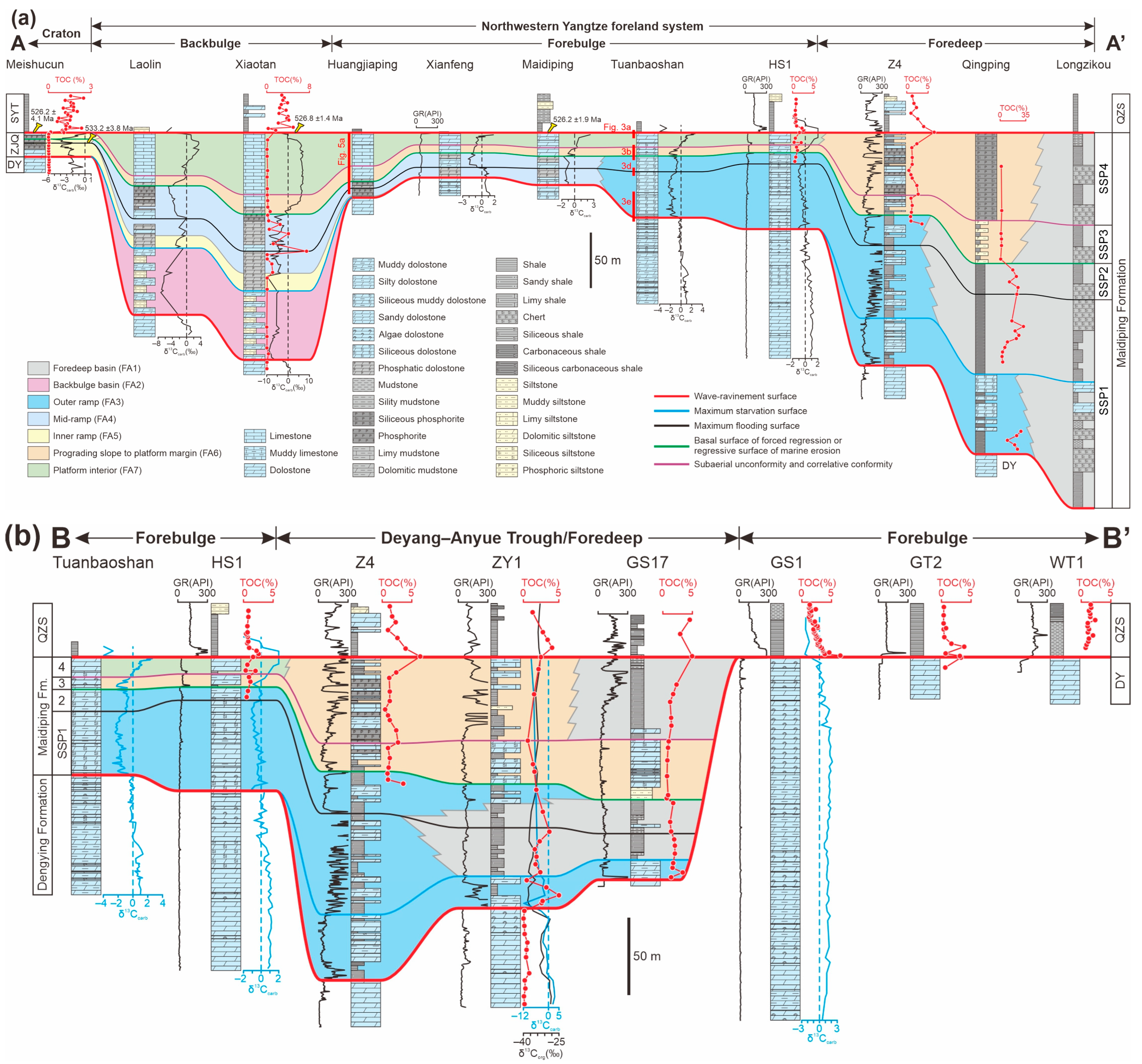

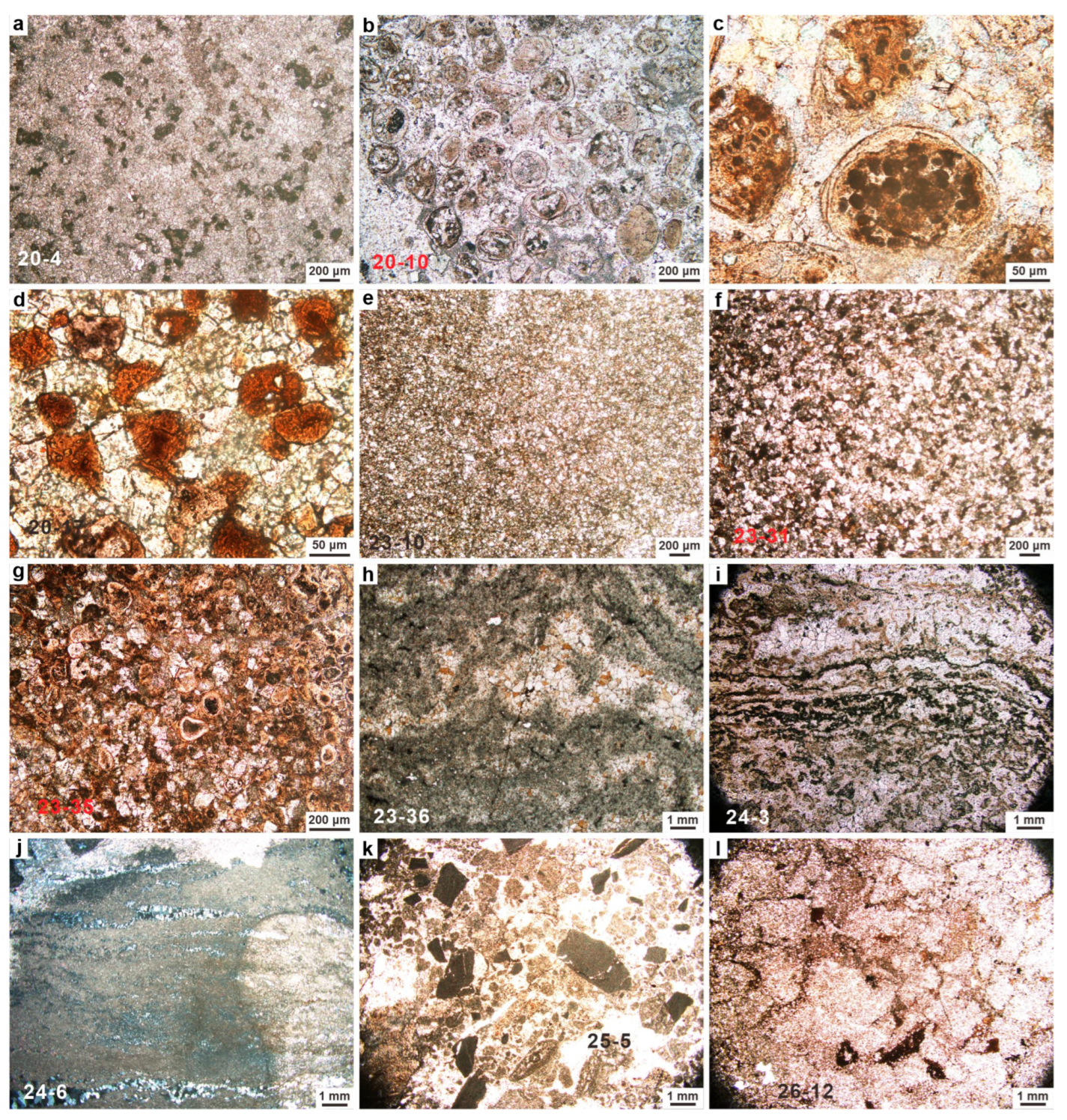
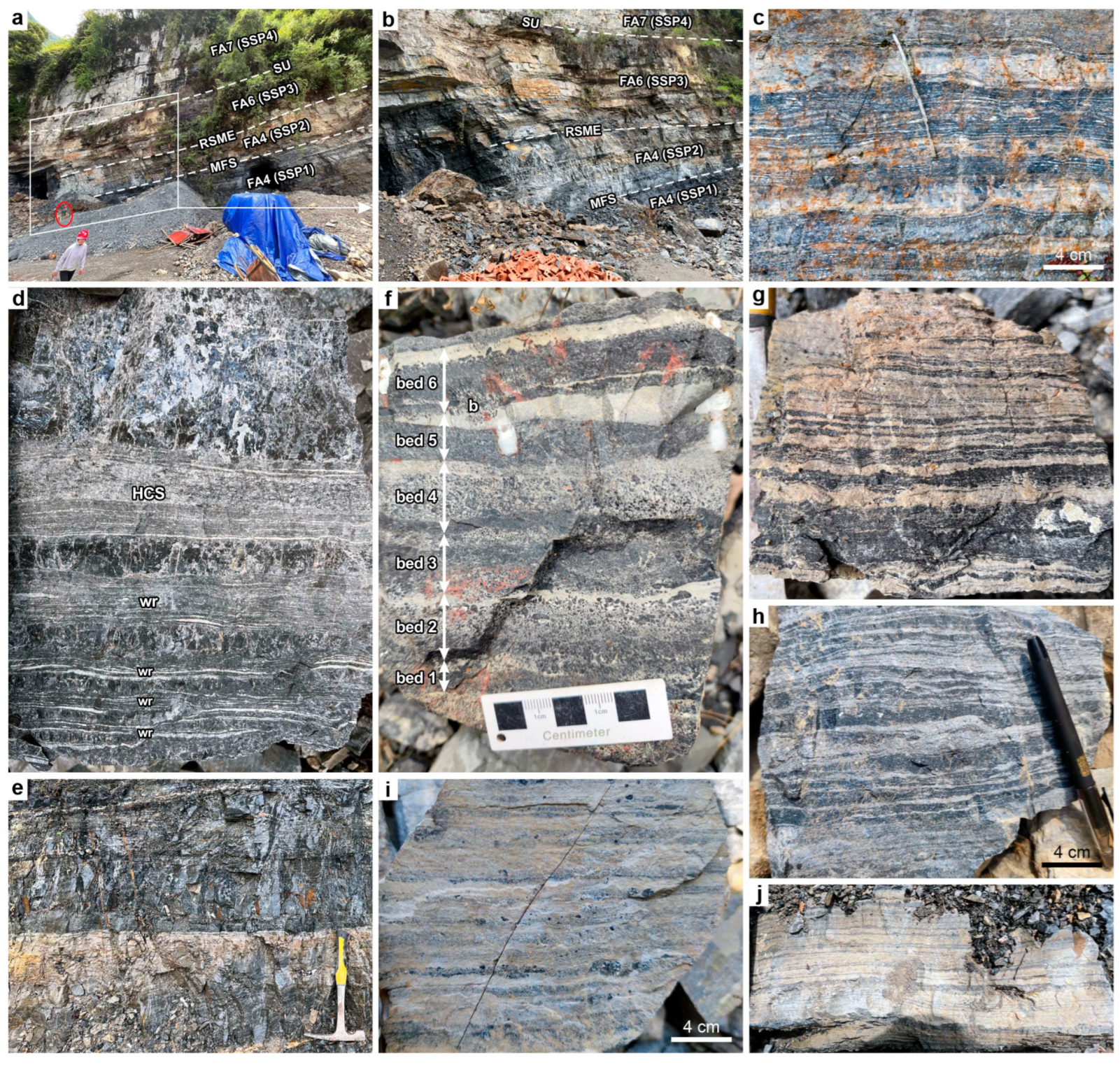
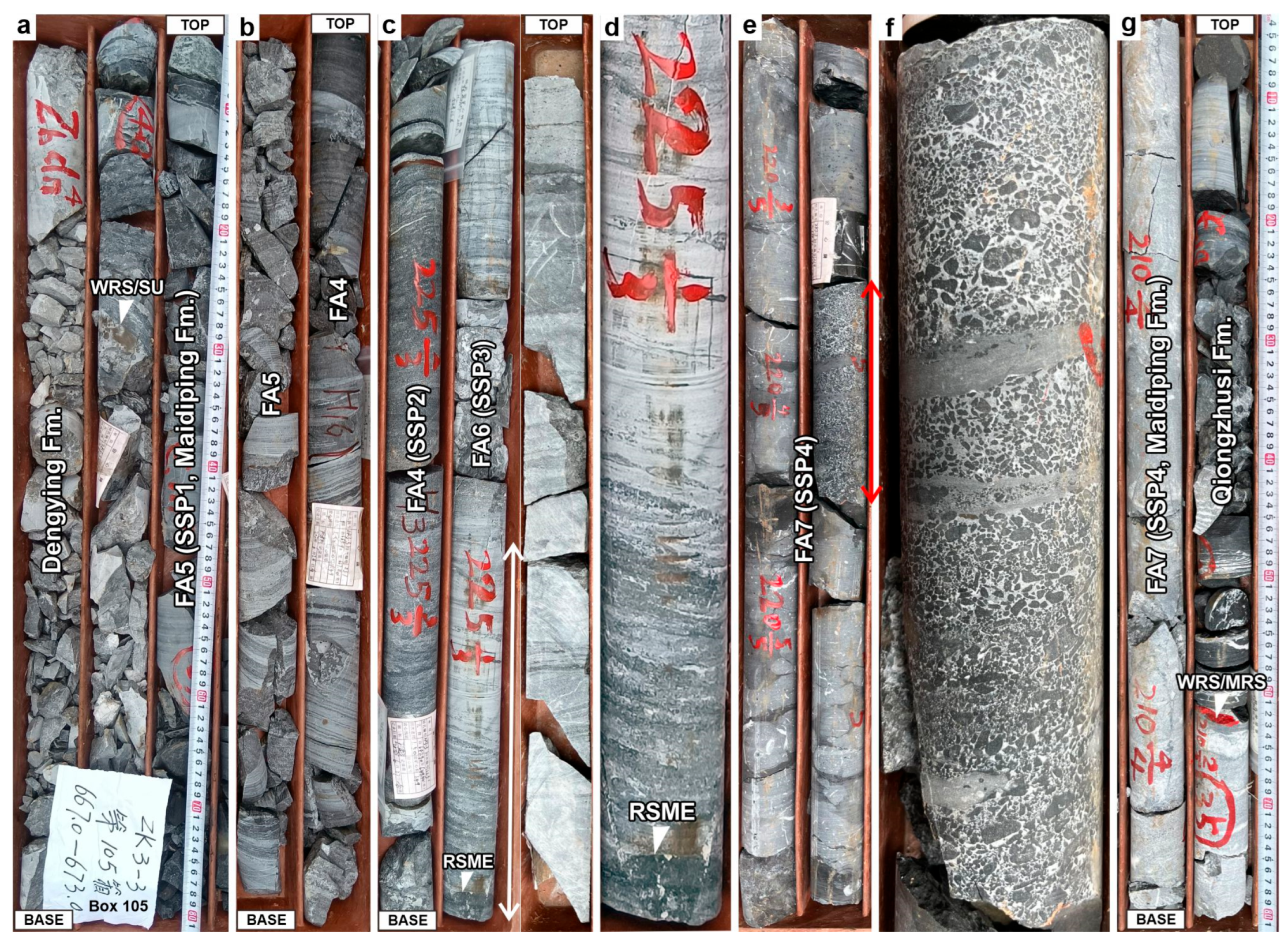
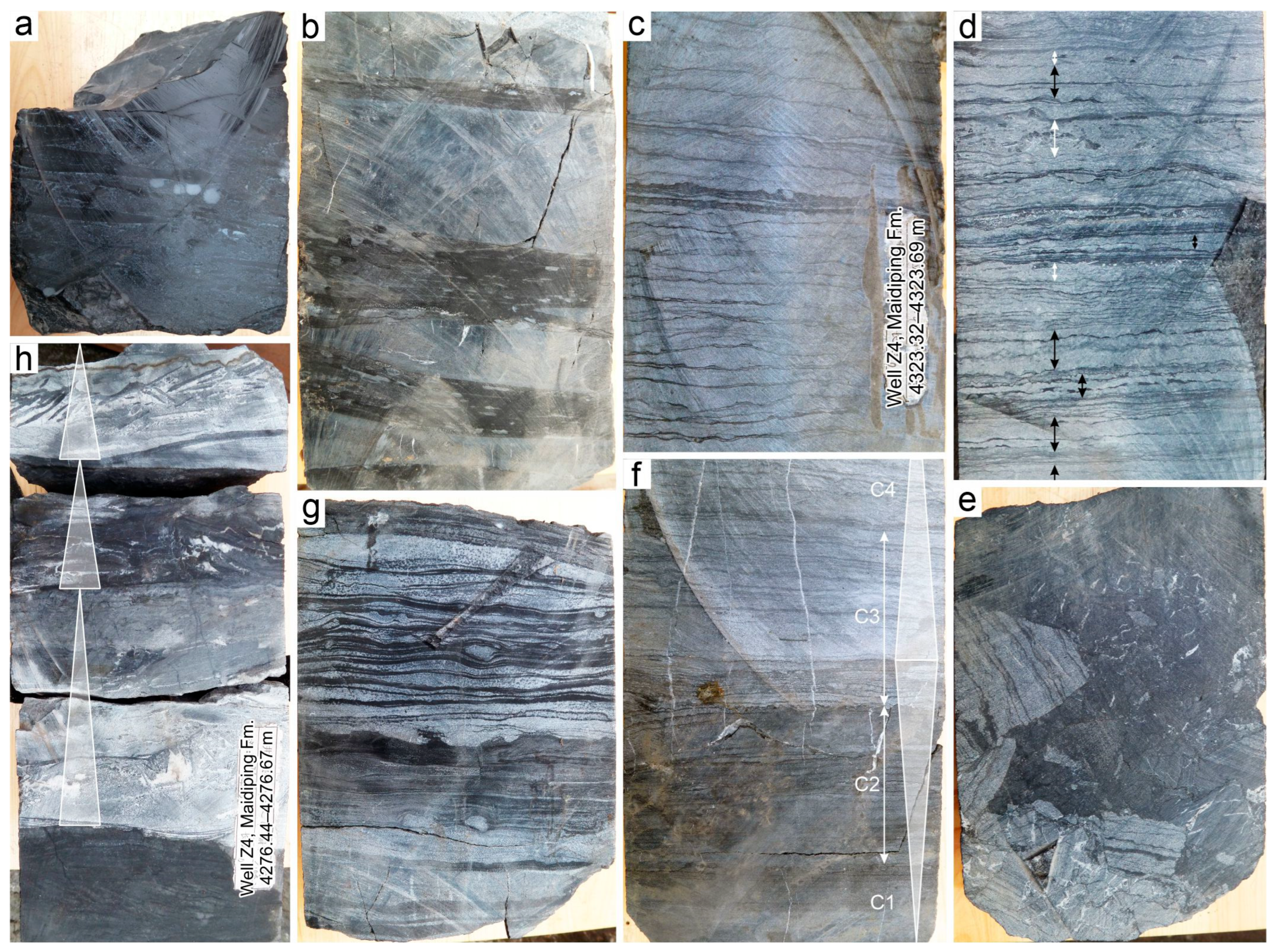

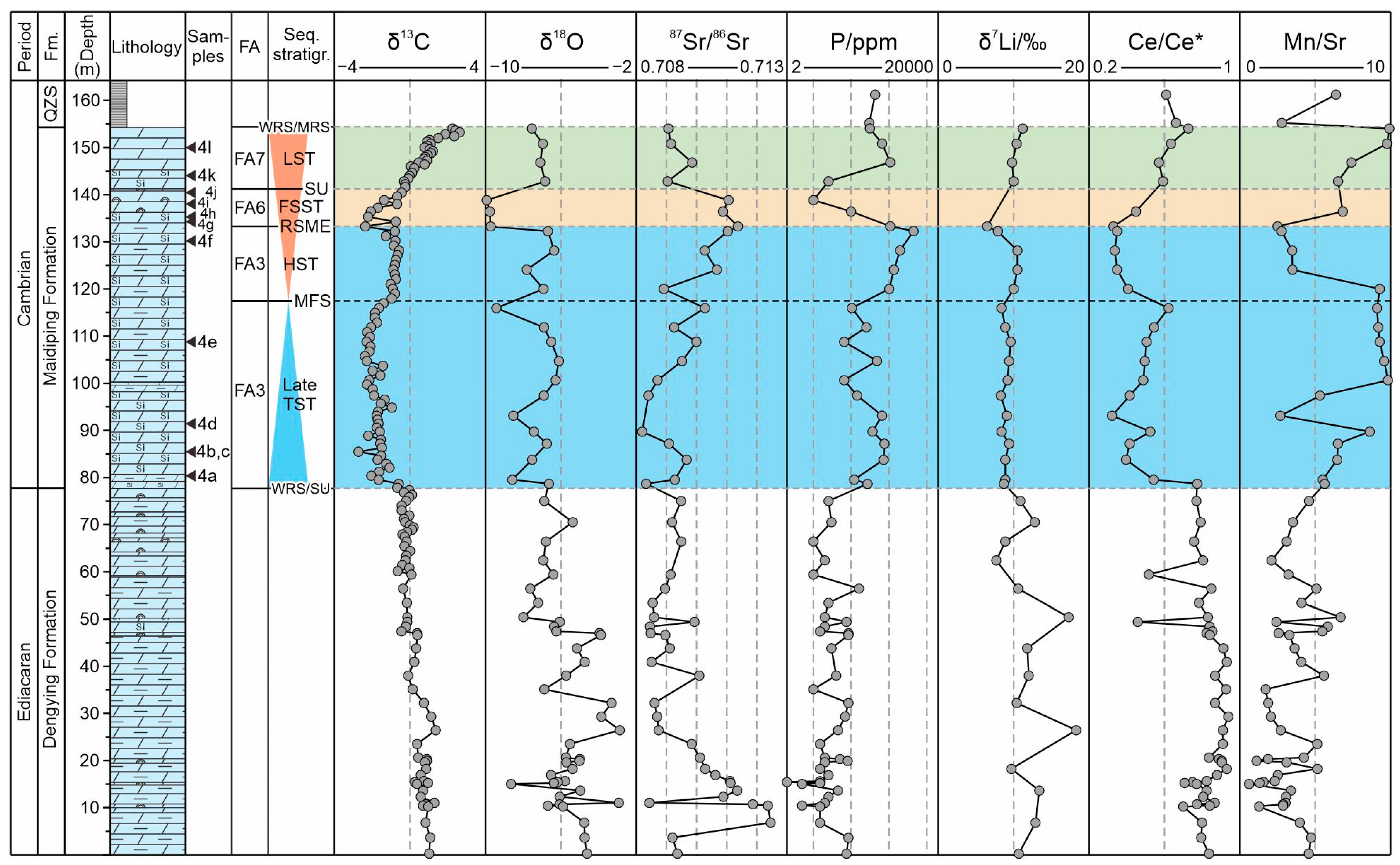
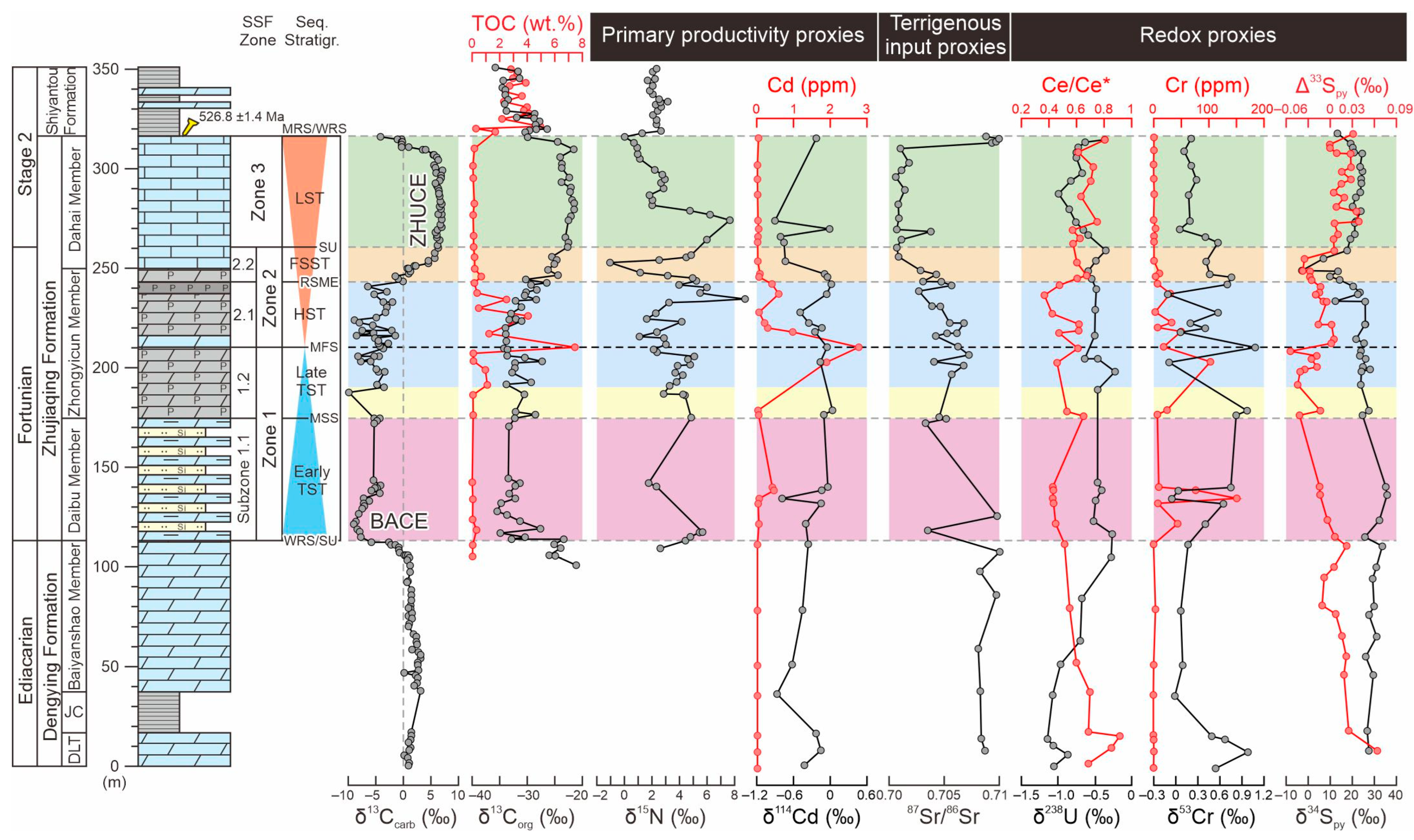


| Facies Associations | Constituent Lithofacies | Description | Interpretation |
|---|---|---|---|
| FA1: Foredeep basin | Bedded chert, siliceous shale, and interbedded chert and siliceous shale | Thinly bedded or interbedded (3−10 cm). Chert beds are structureless. Siliceous shales are finely laminated and contain abundant pyrite bands or nodules. No to very sparse fossil content. | Pelagic chert precipitation and (or alternating with) clay suspension below both storm wave base and euphotic zone in a deep-marine basin setting |
| FA2: Backbulge basin | Interbedded dolomitic chert and siliceous dolomudstone | Thinly interbed (3−10 cm). Dolomitic chert beds are structureless. Siliceous dolomudstone beds show horizontal lamination or wave-ripple cross-lamination. No to very sparse fossil content. | Alternating dolomitization and silicification below both storm wave base and euphotic zone in a deep-marine basin setting. The wave-ripple cross-lamination indicates episodic storms |
| FA3: Outer ramp | Interbedded siliceous dolomudstone and shale and interbedded dolomudstone and chert | Thinly interbedded (3−10 cm). Locally containing mud pebbles floating in matrix. Mud clasts are principally derived from underlying beds. | Alternating dolomitization and clay suspension or silicification below storm wave base in an outer ramp setting |
| FA4: Mid-ramp | Interbedded phosclast grainstone and microsphorite or chert | Sharply based, hummocky to wave-ripple cross-laminated, very fine to fine-grained phosclast beds intercalated with cherts or microsphorites. | Alternating deposition of phosphatic tempestites and fair-weather cherts and microsphorites between fair-weather and storm wave bases in a mid-ramp setting |
| FA5: Inner ramp | Structureless phosclast grainstone | Amalgamated, thinly bedded phosclast grainstone beds. Each bed is erosively based, structureless, and consists of poorly sorted, sand to gravel-sized phosphatic grains upward cemented by dolomite. | Deposition of amalgamated phosphatic tempestites just above fair-weather wave base |
| Interbedded phosclast grainstone and dolomudstone | Thinly interbedded. Each dolomudstone bed shows sharp or distinct contact with the underlying phosclast grainstone bed. | Alternating deposition of phosphatic tempestites and fair-weather dolomudstones just above fair-weather wave base | |
| Hummocky to low-angle cross-laminated dolograinstone | Thinly bedded. Hummocky to low-angle cross-lamination. | Deposition of dolomitic tempestites in a shallow subtidal shoreface setting | |
| Interbedded phosclast grainstone and stromatolitic dolobindstone | Very thinly to thinly interbedded. Gradually merging upward succession of stromatolitic dolobindstone beds intercalated with phosclast grainstones. | Deposition of phosclast grainstones by tidal currents and waves alternating with slack-water microbial growth in a shallow subtidal to intertidal flat setting | |
| Wavy-bedded mixed phosclast grainstone–dolomudstone heterolith | Thinly interbedded. Wavy bedding. Phosclast beds consist of pebbly medium to very coarse phosphatic grains cemented by dolomite. | Alternating deposition of tide and wave-winnowed phosclast grainstones and slack-water dolomudstones in an intertidal flat setting | |
| FA6: Prograding slope and platform margin | Algal dolobindstone, doloframestone, dolograinstone, graded phosclast beds, and dolobindstone or phosphatic breccias | Phosphatic coated grains. Flat-clast conglomerates and breccias. Amalgamated, phosclast beds. Each bed is normally graded and consists of poorly sorted, sand-sized phosphatic grains cemented by dolomite. Algal laminae. | Deposition of turbidites and debrites between fair-weather and storm wave bases in a prograding slope setting, and reefs and sand shoals above the fair-weather wave base in a prograding platform margin setting |
| FA7: Platform interior | Lime mudstone, dolomudstone, and phosclast rudstone | Thinly bedded. Nodular bedding. Phosclast beds consist of poorly sorted, sand to gravel-sized phosphatic grains cemented by dolomite. | Deposition above fair-weather wave base in an expanding platform interior |
Disclaimer/Publisher’s Note: The statements, opinions and data contained in all publications are solely those of the individual author(s) and contributor(s) and not of MDPI and/or the editor(s). MDPI and/or the editor(s) disclaim responsibility for any injury to people or property resulting from any ideas, methods, instructions or products referred to in the content. |
© 2025 by the authors. Licensee MDPI, Basel, Switzerland. This article is an open access article distributed under the terms and conditions of the Creative Commons Attribution (CC BY) license (https://creativecommons.org/licenses/by/4.0/).
Share and Cite
Liu, J.; Jiang, Q.; Zhang, Y.; Liu, J.; Ai, Y.; Duan, P.; Zhu, G. Earliest Cambrian Carbonate Platform Evolution, Environmental Change, and Organic Matter Accumulation in the Northwestern Yangtze Block, South China. Minerals 2025, 15, 812. https://doi.org/10.3390/min15080812
Liu J, Jiang Q, Zhang Y, Liu J, Ai Y, Duan P, Zhu G. Earliest Cambrian Carbonate Platform Evolution, Environmental Change, and Organic Matter Accumulation in the Northwestern Yangtze Block, South China. Minerals. 2025; 15(8):812. https://doi.org/10.3390/min15080812
Chicago/Turabian StyleLiu, Jincheng, Qingchun Jiang, Yan Zhang, Jingjiang Liu, Yifei Ai, Pengzhen Duan, and Guangyou Zhu. 2025. "Earliest Cambrian Carbonate Platform Evolution, Environmental Change, and Organic Matter Accumulation in the Northwestern Yangtze Block, South China" Minerals 15, no. 8: 812. https://doi.org/10.3390/min15080812
APA StyleLiu, J., Jiang, Q., Zhang, Y., Liu, J., Ai, Y., Duan, P., & Zhu, G. (2025). Earliest Cambrian Carbonate Platform Evolution, Environmental Change, and Organic Matter Accumulation in the Northwestern Yangtze Block, South China. Minerals, 15(8), 812. https://doi.org/10.3390/min15080812





